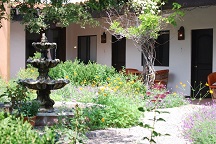
The solar panels were expensive—$170,000—but Schmitt expects a return on investment of 4.5 years. Already, the B&B’s owners have obtained grants totaling $67,000 and may receive yet another for $42,000.
The inn’s owners’ approach to sustainability appeals to their clientele—bird watchers and naturalists. The inn is adjacent to the San Pedro Riparian National Conservation Area and is situated on 10 acres bordering the San Pedro River. The broad grasslands in the valley and the cottonwood and willow trees along the river provide a constant supply of food, shelter and water for wildlife. The unique habitat attract more than 335 species of birds, 82 species of mammals, and 47 species of amphibians and reptiles.
Building is 17 Years Old

“When we first got here, the heating systems were inefficient, overtaxed, and undersized,” Schmitt says. “We went to propane heat. There were five utility cabinets—each with a hot water tank. We replaced the hot water tanks with flash propane water heaters.” Schmitt adds that he and Dome are currently considering high SEER rated mini-split systems for heating and air-conditioning.
The approximately 200 incandescent light bulbs were replaced with compact fluorescents and LEDs. Washers and dryers were upgraded.
“We had to replace showerheads, toilets, and faucets with low-flow versions,” Schmitt says.
Dispensers replaced amenity bottles in guestroom bathrooms and a recycling program was put in place. About 90 percent of the B&B’s waste now gets recycled. Vegetable matter is composted.
“Our guests expect us to recycle,” Schmitt says. “They would be disappointed if we were not doing that.”
Other green initiatives include:
• Xeriscaping with native plants and drip irrigation;
• The use of recycled products where available;
• Towel and linen reuse program;
• Use of environmentally certified cleaning and laundry products;
• Reverse osmosis water dispensers for drinking water, replacing the use of plastic water bottles;
• Using only fair trade, small producer cooperative, environmentally certified coffee products; and
• Using locally grown organic fruits, vegetables and meats when available.
“Over the course of time all of these things have reduced our footprint,” Schmitt says. “The investments have improved the value of the property and improved our bottom line. I would recommend it to anyone.”
Go to the Casa de San Pedro B&B.
Glenn Hasek can be reached at editor@greenlodgingnews.com.





